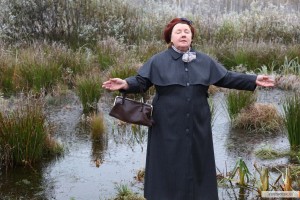By Christina Romine
Still from Mikhail Segal’s 2012 film Short Stories
OXFORD, Ohio- The museum doors stayed open later than usual for students and staff. “The lecture is ready to begin,” called a museum employee. Thirty guests filed into the dimly-lit lecture hall, taking their seats. A power-point appeared on the screen, and the guest lecturer clicked through pictures of Russian film posters, art, and President Vladimir Putin’s self-promoting propaganda.
Wednesday, October 21st, the Havighurst Center for Russian and Post-Soviet Studies invited Helena Goscilo, a professor of Slavic and Eastern European Languages and Literature at the Ohio State University, to present her lecture “The New Janus: Russia’s Visual Identity in the 21st Century”. She used the image of the Roman god Janus, with one face to the future and one face to the past, as a metaphor for Russia to explore the transition in Russian culture from the Post-Soviet era of the 1990’s to the current era under Putin. Goscilo also discussed Putin as a cultural icon.
“Sochi is evidence of Putin’s desire to place Russia on the map of world leaders,” said Goscilo. “The annexation of Crimea demonstrates Putin’s ambition.”
With Russia being at the center of current media and international, the Havighurst Center capitalized on the increasing student interest in Russia by utilizing art and film for its fall lecture series.
This fall, the Havighurst Center partnered with the Miami University Art Museum to present the exhibition Margaret Bourke-White: Photographs of the USSR and a connecting lecture series. They invited 3 guest speakers to present on different topics at the museum, Goscilo’s lecture being the last. The art exhibit features photographs taken by Bourke-White in Soviet Russia from 1930-1932, during a period of starvation under Joseph Stalin’s leadership.
Emily Walton, a Junior Fellow of the Havighurst Center and a double major in Russian, Eastern European and Eurasian Studies and Political Science, attended Goscilo’s lecture and art exhibition. “This has a huge impact for the Havighurst program,” she said. “It’s really cool to have this exhibition at Miami and to have this distinguished lecturer.”
Karen Dawisha, director of the Havighurst Center, commented on the lecture. “We are doing a lot more on Russian power projection. This was quite unusual because it’s connected to an art exhibition.”
“Students should attend our programs if they want to broaden the context of what they’re studying,” Dawisha said. “You can learn so much about Russian society by watching one of the films.”
Dawisha refers the film series hosted by the Havighurst Center, “The New Culture Wars and the Return of Censorship in Contemporary Russian Cinema”. The films are displayed in its original Russian language with English subtitles.
Irina Anisimova, a visiting assistant professor who earned her Ph.D. from the University of Pittsburgh, presented Short Stories, the latest instalment of the film series, on Thursday October 22nd. The comedy-drama is centered on a manuscript of 4 short stories. Each short story comes to life as it is ready by employees at a publishing house.
Anisimova said in her introduction, “The film plays with the idea of literature as a central art in Russia.”
The film also commented on a generational divide through a comedic back and forth in the final segment. In the scene, a middle-aged gentleman becomes romantically involved with a much younger woman- only to discover that she knew nothing of life before the fall of the Soviet Union. “How many died between the Civil War, Stalin, and two World Wars?” he paused to ask her. She labored over her calculations, finally rounding her answer up to 500,000 people. The audience erupted in laughter at the man’s incredulous disgust towards his partner’s ignorance. Amidst the comedy, the film gave insight to modern Russian life, while offering a commentary on the past.
“This film is a great example that combats current stereotypes of Russia,” said Stephen Norris, the associate director of the Havighurst Center.
The Margaret Bourke-White Art Exhibition will be on display at the Miami University Art Museum until December 12. The Museum is open from 10 a.m. until 5 p.m. Tuesday through Friday, and 12 p.m. to 5 p.m. Saturday. Admission to the gallery is free.
“The New Culture Wars and the Return of Censorship in Contemporary Russian Cinema” film series has two more installments for viewing. Ordered to Forget will be presented on November 5th by Norris, and Leviathan will be introduced by Anisimova on November 12th. Both films will be presented in Irvin Hall Room 040, beginning at 5:30 p.m.
Christina Romine is a senior at Miami majoring in International Studies.

